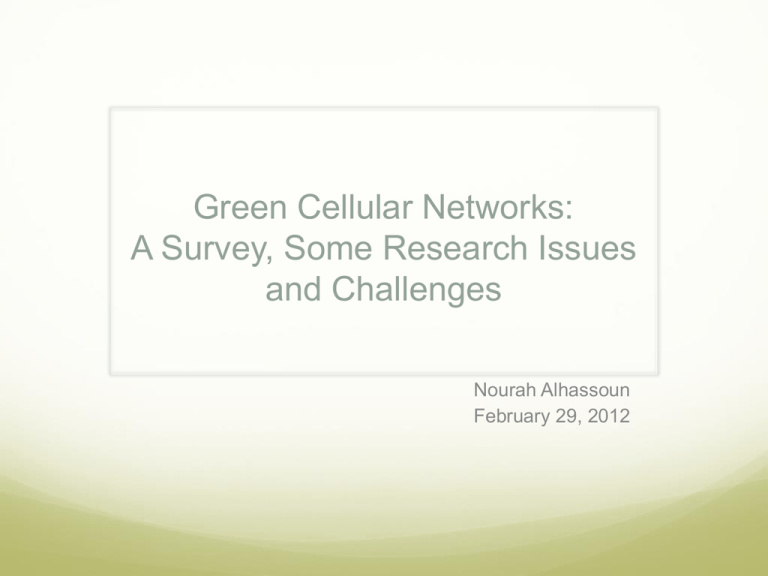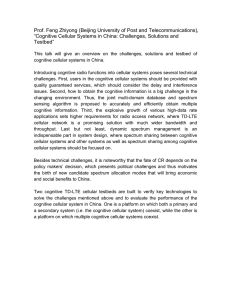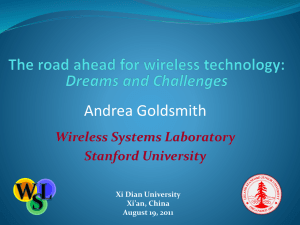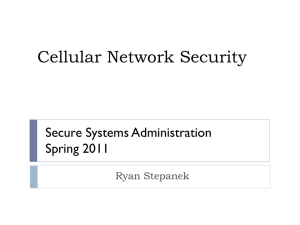Alhassoun
advertisement

Green Cellular Networks: A Survey, Some Research Issues and Challenges Nourah Alhassoun February 29, 2012 Part I Objective: A brief survey of methods to improve the power efficiency of cellular networks and explore some research issues and challenges Suggest some techniques to enable an energy efficient or green cellular network Results: A survey on methods to obtain energy savings in base stations such as architectural changes in base stations and heterogeneous network deployment Propose a research vision by using some techniques(cognitive radio and cooperative relaying technologies) to make energy more efficient Part II Important Aspects of a Green Networking: I. Defining Green Metrics II. Architecture Changes in Base Stations III. Network Planning IV. Addressing Energy Efficiency in Future Generation Wireless Systems V. Some Broader Perspectives I. Measuring Greenness Energy Efficiency Metrics: Facility-level: High-level systems where equipment is deployed Equipment-level: Evaluate performance of an individual equipment Network-level: Assess the performance of equipment with the consideration of features and properties II. Architecture: Energy Saving in Base Stations Minimizing BS Energy Consumption Improvements in Power Amplifier: Switch mode PA Power Saving Protocols: Sleep Mode Energy Aware Cooperative BS Power Management Cell Zooming: BS can adjust its size according to network or traffic situation Renewable Energy Resources Solar and Wind Energy instead of off-grid sites III. Network Planning Heterogeneous Network Deployment: Based on smaller cells such as micro, pico and femtocells Advantages: Energy consumption of the network can be reduced up to 60% compared to a network with macro-cells only Smaller cells use higher frequency bands to provide high data rates Draw Backs: The efficiency of macro-cell Base Station might be reduced Part III IV. Addressing Energy Efficiency in Future Generation Wireless Systems Enabling Technologies: Green Communication via Cognitive Radio: Purpose: Collect information on the spectrum usage and access the unused frequency bands Manage the spectrum optimally and dynamically Green Communication delivered by Cooperative Relays: Purpose: Improvement in throughput and coverage Provide service to more users using less power IV. Addressing Energy Efficiency in Future Generation Wireless Systems Low Energy Spectrum Sensing Cognitive Radio: design low complex cyclostationary detectors instead of energy detectors Energy Efficient Resource Management with Applications in Heterogeneous Networks Relay placement, optimal relay selection criterion Addressing Uncertainty Issues Cognitive Radio: did not take into account the effect of imperfect sensing Cooperative Relays: optimal relays with perfect CSI VI. Some Broader Perspective Ideas to achieve energy efficient cellular network: Statistical Power Profiles: Dynamic algorithms can be designed to switch BS to different power profile appropriate for that time of the day Smart Grid Technology: Adding measurement sensors which can update the status of BSs then transmit them to other BSs and smart grid control system Embodied Energy: Reducing the number of BS since embodied energy accounts for a significant proportion of energy consumed by the BS Energy Saving Obtained by Some of the Discussed Techniques Reference Hasan, Z. Boostanimehr, H. 2011. “Green Cellular Networks: A survey, some research issues and challenges”. IEEE Communications Survey & Tutorials. V13,2,4.











